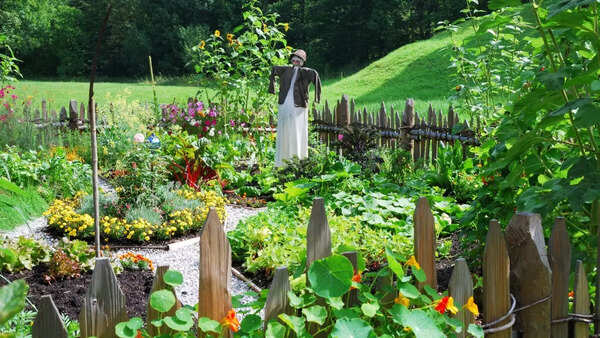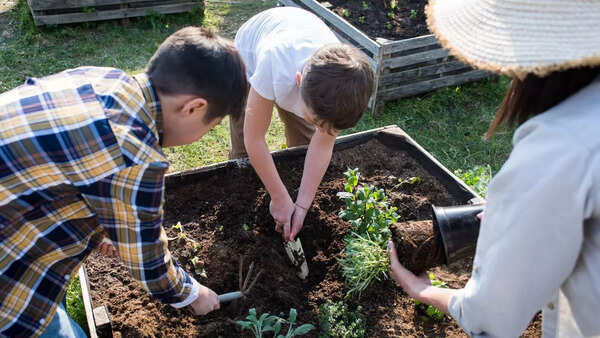The monsoon season offers an ideal environment for kitchen gardening, with gentle showers and optimal temperatures promoting seed germination and nutrient absorption. Gardeners can cultivate leafy greens, root vegetables, legumes, fruiting vegetables, and herbs. Natural irrigation, pest balance, and enhanced soil fertility contribute to fresher, healthier produce, making it a rewarding time to reconnect with nature.
The monsoon season breathes life back into the earth, offering respite from the summer heat. For gardeners, it's the perfect time to cultivate a kitchen garden. The combination of abundant rainfall, softened soil, and moderate temperatures creates an ideal environment for growing your own food.
Whether you are an experienced gardener or just starting out, the monsoon offers a unique opportunity to connect with nature and experience the satisfaction of growing your own produce.

Why the Monsoon Season is Ideal
The monsoon season offers several advantages for starting a kitchen garden:
- Reduced Watering: Consistent rainfall minimizes the need for manual watering.
- Optimal Germination: Temperatures between 20°C and 30°C encourage seed germination.
- Enhanced Nutrient Absorption: High humidity improves nutrient uptake by plants.
- Soil Moisture: Gentle showers maintain soil moisture, promoting healthy growth.
Remember to ensure proper drainage to prevent waterlogging.
How to Start a Kitchen Garden This Monsoon: A Step-by-Step Guide
Here's a simple guide to help you start your kitchen garden this monsoon season:
- Choose the Right Location: Select a spot that receives 4-6 hours of indirect sunlight daily and isn't prone to waterlogging.

- Prepare the Soil: Lightly loosen the soil, add compost, and ensure good drainage.
- Plant Seeds or Seedlings: Follow recommended spacing guidelines for optimal growth.
- Water Wisely: Rely primarily on rainwater, but monitor moisture levels and avoid waterlogging.
- Mulch for Moisture Retention: Apply dried leaves or straw as mulch to retain moisture and regulate soil temperature.
- Control Pests Naturally: Use neem oil or garlic-chili spray to deter pests without harmful chemicals.
- Harvest Regularly: Pick leafy greens and young vegetables frequently to encourage continuous production.
Preparing Your Soil for Monsoon Planting
Monsoon rains naturally soften the soil, making it easier to work with. To further enrich the soil:
- Mix in organic compost, farmyard manure, or leaf mold. These will decompose quickly in the moist conditions, releasing essential nutrients.
- Add natural supplements like neem cake or bone meal to enhance nutrition and pest resistance.
- Test soil drainage by digging a small hole and filling it with water. The water should drain within 2-4 hours.
- For clay-heavy soils, incorporate cocopeat or coarse sand to improve aeration and prevent waterlogging.
Key Benefits of Monsoon Cultivation
- Natural Irrigation: Rainfall reduces the need for manual watering, saving time and resources.
- Ideal Growing Conditions: Moderate temperatures and high humidity create an optimal environment for plant growth.
- Natural Pest Control: A humid environment promotes beneficial organisms that suppress harmful pests.
- Improved Soil Fertility: Organic matter breaks down rapidly, enriching the soil and providing essential nutrients.
- Fresher, Healthier Produce: Homegrown vegetables are fresher, chemical-free, and packed with nutrients.
Best Vegetables and Herbs to Grow
Consider these options for your monsoon kitchen garden:
- Leafy Greens: Spinach, fenugreek, amaranth, and coriander thrive in moist conditions.
- Root Vegetables: Radishes and short varieties of carrots grow well in softened soil.
- Legumes: French beans, cluster beans, and peas add nitrogen to the soil.
- Fruiting Vegetables: Tomatoes and chilies prefer good drainage and sunlight.
- Herbs: Mint, basil, and dill are flavorful and help manage pests.


 5 Overlooked Warning Signs of Colon Cancer: Early Detection Saves Lives
5 Overlooked Warning Signs of Colon Cancer: Early Detection Saves Lives
 Shukla's ISS Arrival Heralds New Era for Indian Space Exploration; Gaganyaan Mission Looms
Shukla's ISS Arrival Heralds New Era for Indian Space Exploration; Gaganyaan Mission Looms
 Vijay Sethupathi Apologizes Amid Controversy Over Son Surya's Film 'Phoenix'; Thalapathy Vijay's Support Revealed
Vijay Sethupathi Apologizes Amid Controversy Over Son Surya's Film 'Phoenix'; Thalapathy Vijay's Support Revealed
 Android Security Alert: Government Warns of Critical Flaws Exposing User Data
Android Security Alert: Government Warns of Critical Flaws Exposing User Data
 Skin Deep: 7 Warning Signs on Your Skin That Could Signal Heart Trouble
Skin Deep: 7 Warning Signs on Your Skin That Could Signal Heart Trouble
 Ashada Gupt Navratri 2025: Dates, Significance, and How to Observe This Hidden Festival
Ashada Gupt Navratri 2025: Dates, Significance, and How to Observe This Hidden Festival
 Smith Eyes Grenada Test Return After Injury Layoff
Smith Eyes Grenada Test Return After Injury Layoff
 Staying Hydrated May Significantly Lower Risk of Heart Failure, New Study Suggests
Staying Hydrated May Significantly Lower Risk of Heart Failure, New Study Suggests
 Moto G54 Price Slashed in India: Check Out the New, Lowered Costs
Moto G54 Price Slashed in India: Check Out the New, Lowered Costs
 Gambhir Sidelines Pant's Twin Tons After India's Test Loss, Emphasizes Team Performance
Gambhir Sidelines Pant's Twin Tons After India's Test Loss, Emphasizes Team Performance